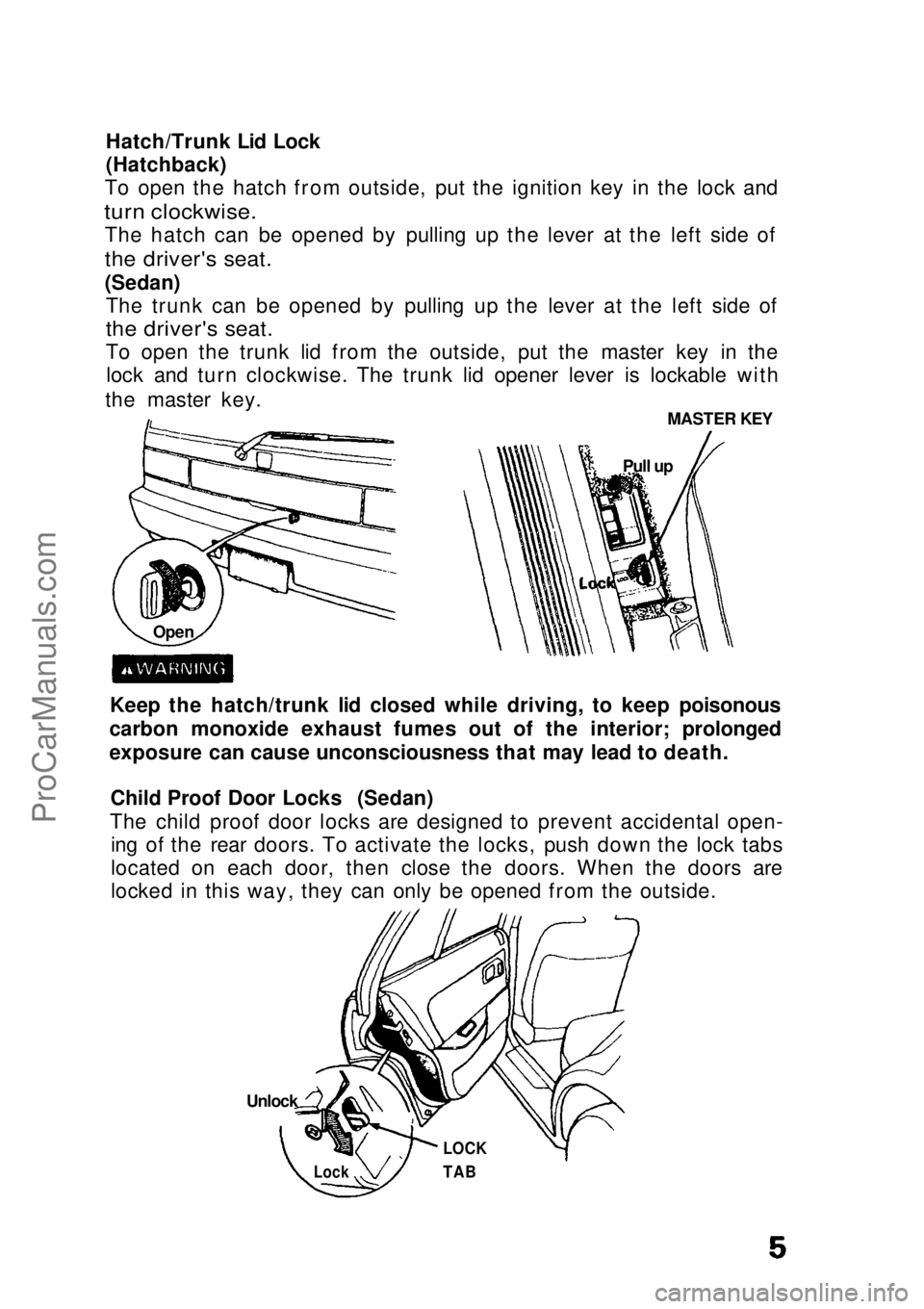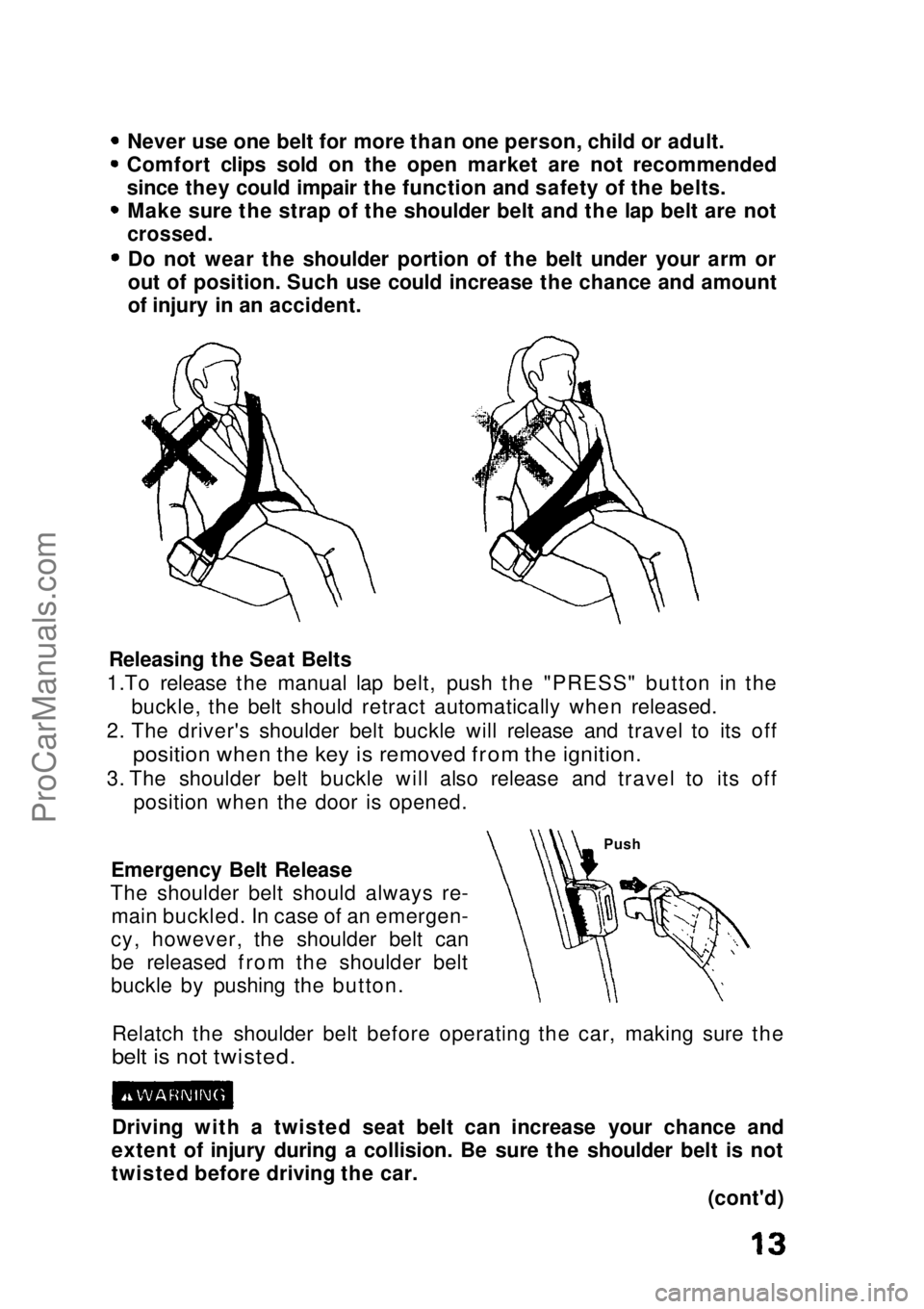Page 6 of 136

Hatch/Trunk Lid Lock
(Hatchback)
To open the hatch from outside, put the ignition key in the lock and
turn clockwise.
The hatch can be opened by pulling up the lever at the left side of
the driver's seat.
(Sedan) The trunk can be opened by pulling up the lever at the left side of
the driver's seat.
To open the trunk lid from the outside, put the master key in thelock and turn clockwise. The trunk lid opener lever is lockable with
the master key.
Keep the hatch/trunk lid closed while driving, to keep poisonous
carbon monoxide exhaust fumes out of the interior; prolonged
exposure can cause unconsciousness that may lead to death.
Child Proof Door Locks (Sedan)
The child proof door locks are designed to prevent accidental open- ing of the rear doors. To activate the locks, push down the lock tabs
located on each door, then close the doors. When the doors are
locked in this way, they can only be opened from the outside. Open
Unlock
LOCK
TAB
Lock
MASTER KEY
Pull upProCarManuals.comMain Menu s t
Page 11 of 136
Your Honda is provided with seat belts to minimize the chance of
injury to yourself and your passengers in a sudden stop or accident.For precautions on using seat belts for children, babies and pregnant
women, see pages 21 — 25.
Seat belts are most effective when the driver and passengers are
sitting up straight and well back in the seat.
In the event of a collision, occupants not wearing seat belts could
be seriously or fatally injured. Make sure you and all your
passengers ALWAYS put on the seat belts before driving away.
CAUTION:
Be careful the seat helts are not damaged by catching or
entangling in the door or seat mechanism.
NOTE:
The front seat belt restraint system is different on the car you use.
See pages 11 through 14 for the automatic ("passive") shoulder
belt system on the Sedan. See pages 15 through 18 for the
automatic ("passive") lap/shoulder belt system on the Hatchback. Seat BeltsProCarManuals.comMain Menu s t
Page 14 of 136

Never use one belt for more than one person, child or adult.
Comfort clips sold on the open market are not recommended
since they could impair the function and safety of the belts. Make sure the strap of the shoulder belt and the lap belt are not
crossed.
Do not wear the shoulder portion of the belt under your arm or
out of position. Such use could increase the chance and amount
of injury in an accident.
Releasing the Seat Belts
1.To release the manual lap belt, push the "PRESS" button in the buckle, the belt should retract automatically when released.
2. The driver's shoulder belt buckle will release and travel to its off
position when the key is removed from the ignition.
3. The shoulder belt buckle will also release and travel to its off position when the door is opened.
Emergency Belt Release
The shoulder belt should always re- main buckled. In case of an emergen-
cy, however, the shoulder belt can
be released from the shoulder belt
buckle by pushing the button.
Relatch the shoulder belt before operating the car, making sure the
belt is not twisted.
Driving with a twisted seat belt can increase your chance and
extent of injury during a collision. Be sure the shoulder belt is not
twisted before driving the car. Push
(cont'd)ProCarManuals.comMain Menu s t
Page 17 of 136
Seat Belts (cont'd)
Avoid placing the lap belt across your abdomen. In the event ofa collision, the pressure of the belt on the abdomen may
increase the extent of injury. Do not wear the shoulder portion of the belt under your arm or
out of position. Such use could increase the chance and amount
of injury in an accident.
Never use one belt for more than one person, child or adult. Comfort clips sold on the open market are not recommended
since they could impair the function and safety of the belts.
Emergency Belt Release
The front belts should remain permanently latched. However, an emergency release button is provided as shown.
EMERGENCY
RELEASE BUTTON TONGUE PLATE
BUCKLE
Too high
Keep below hip boneProCarManuals.comMain Menu s t
Page 22 of 136

Child Restraint
Children riding in the car should be restrained to minimize the risk of
injury in an accident, sudden stop or sudden maneuver.
According to accident statistics provided to the National Highway
Traffic Safety Administration (NHTSA), children are safer when
properly restrained in the rear seating positions than in the front
seat.
For smaller children, we strongly recommend the use of a
commercially available child restraint system that meets the Federal
Motor Vehicle Safety Standard (FMVSS) because it offers the most
protection against injury. All states now have laws which require
that small children must be seated in a child passenger seat restraint
system. Check local laws.
Before buying a particular child restraint system, make sure it fits
your car seat and seat belts, and fits your child. Follow the child seat manufacturer's instructions when installing the seat.
Children who have outgrown the child restraint system should useone of the seat belts.
Make sure the belt is snug against the child's body with the
shoulder portion going over the shoulder and across the body to
evenly distribute the belt's restraining force.
Check that the lap portion of the belt is positioned low on the
child's hipbone and below the abdomen.
This way if the car is involved in an accident, the child would be less likely to slide under the seat belts. If the belt is too close to the child's neck or throat, you may want
to consider putting the child in an automobile booster seat that meets the Federal Motor Vehicle Safety Standard (FMVSS).
Children should never ride unrestrained in an automobile.
Never use an infant carrier or child safety seat that "hooks"
over a seat-back; it may not provide adequate security in an
accident. Never allow a child to be held in a person's arms while they are
in a moving vehicle. Holding a child in a moving vehicle does not
provide the child with any means of protection during an
accident, even if the person holding the child is wearing a seat
belt.
(cont'd)ProCarManuals.comMain Menu s t
Page 23 of 136
Seat Belts (cont'd)
[Hatchback]
Installation of Child Seat
All child restraint systems are designed to be secured by lap belts or
the lap belt portion of a lap-shoulder belt. Children could be endangered in a crash, if their child restraints are not properlysecured. Follow the child seat manufacturer's instructions when
installing the seat.
Your Honda automobile is equipped with attachment points
specifically for a rear seat mounted child restraint system which
uses a top tether.
The tether attachment points are located on the rear panel beside
the taillight bulb inspection cover.
The automatic lap/shoulder restraint system at the front passengerseat cannot be used to secure a child restraint system. Instead, an
optional lap belt must be installed specifically for securing a child restraint system. Two anchor points have been provided behind the
front passenger seat for installation. The optional lap belt is available
from your Honda dealer.ProCarManuals.comMain Menu s t
Page 24 of 136
To Install A Child Seat
1. Remove the anchor point plugs with a coin or a screwdriver and
install the optional lap belt with
the fasteners that came with the
belt.
2. Once the optional lap belt is installed, follow the instructions
that came with the child restraint system for proper attachment.
Do not use the automatic lap/shoulder belt to secure the child
seat. It will not give enough protection to the child seat and the
child on it. The optional lap belt is for a child seat only. Do not use it for any
other purpose. When the child restraint system is not in use, remove it from
the car or secure it with the seat belt to keep it from becoming a
projectile in the event of an accident.
NOTE: See your Honda dealer for installation of the optional lap belt orthe child restraint system. When not in use, make sure the optional lap belt does not get
caught in the passenger's door or seat mechanism.
(cont'd)
ANCHOR POINTS
PLUGSProCarManuals.comMain Menu s t
Page 25 of 136
![HONDA CIVIC 1991 Owners Manual
Seat Belts (cont'd)
[Sedan]
Installation of Child Seat
All child restraint systems are designed to be secured by lap belts or
the lap belt portion of a lap-shoulder belt. The automatic shoulder HONDA CIVIC 1991 Owners Manual
Seat Belts (cont'd)
[Sedan]
Installation of Child Seat
All child restraint systems are designed to be secured by lap belts or
the lap belt portion of a lap-shoulder belt. The automatic shoulder](/manual-img/13/57901/w960_57901-24.png)
Seat Belts (cont'd)
[Sedan]
Installation of Child Seat
All child restraint systems are designed to be secured by lap belts or
the lap belt portion of a lap-shoulder belt. The automatic shoulder belt system at the front passenger seat should not be used to
secure the child restraint system. If a child seat must be installed on
the front seat, place the shoulder portion of the belt behind the child seat and secure the child seat with the lap belt only.
Children could be endangered in a crash, if their child restraints are
not properly secured. Follow the child seat manufacturer's
instructions when installing the seat.
Your Honda automobile is equipped with attachment pointsspecifically for a rear seat mounted child restraint system which
uses a top tether.
The tether attachment points are located on the rear tray, just behind the rear seat-back.
When the child restraint system is not in use, remove it from the
car or secure it with the seat belt to keep it from becoming aprojectile in the event of an accident.
NOTE:
See your Honda dealer for installation of the child restraint system.ProCarManuals.comMain Menu s t